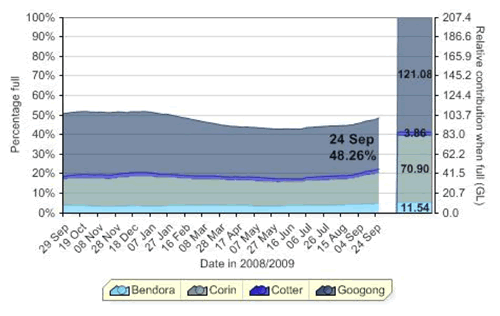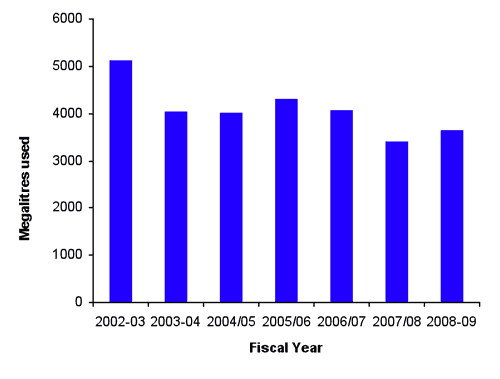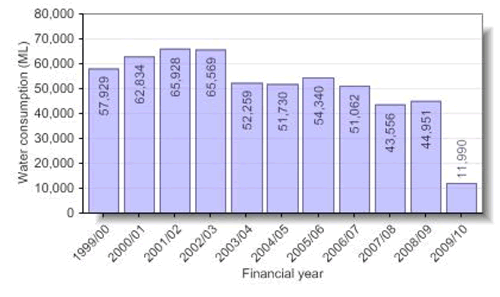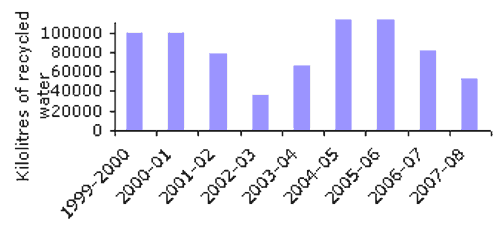Queanbeyan
Indicator: Water Use
Results for this indicator are also available for [an error occurred while processing this directive]
Please note: Text or data highlighted in this colour represent an update to this indicator for the period 2008/09.
What the results tell us for Queanbeyan
Queanbeyan water supply is provided through ActewAGL, which also supplies the whole of Canberra. Queanbeyan uses approximately 8% of the total use in the system. Queanbeyan will benefit from the enhancements in progress for the overall capacity of the ActewAGL system, as it will result in a lower level of restrictions on water use. Both Canberra and Queanbeyan are subject to the same restrictions to water use, and both have policies in place to encourage domestic and commercial users to reduce water consumption. More than 30% reduction in use occurred over the last 5 years. Recycling of wastewater is low.
Supply- how much water could we have?
Queanbeyan has a population of around 38, 593. It is one of the fastest growing areas in NSW, and has proposals for major residential developments. The proposed Googong Town and the residential development at Jerrabomberra have NSW Government support, and are at the environmental assessment stage. These developments will considerably increase the local population and require significant increases in reticulated water supply over the next 5-10 years.
Reticulated drinking water is drawn from several supplies, depending on availability. The majority of the supply under normal rainfall conditions arises from the Cotter system, which consists of the Corin, Bendora and Cotter reservoirs. The other major storage is Googong reservoir, which during the recent drought has had low inflows from the rivers supplying the reservoir. To supplement water availability in the Canberra/Queanbeyan supply, recent rebuilding of the Stromlo Water Treatment Plant has allowed water to be drawn directly from the Murrumbidgee River. Prior to the upgrading only Cotter system water was processed in this plant. This additional water can be used for the normal reticulated supply or pumped back into Googong reservoir to maintain storage levels. Googong reservoir water is processed at Googong Water Treatment Plant, which is connected into the overall supply network. Both water treatment plants incorporate filtration, flocculation, sedimentation and chlorination. In addition the Stromlo plant now has UV post-treatment sterilisation to destroy any residual ~Cryptosporidium` cysts arising from the Murrumbidgee water. The supply is fluoridated.
Two major developments, currently being progressed, to enhance the Canberra/Queanbeyan water supply are the enlarged Lower Cotter dam, which will increase capacity of that storage from about 4 GL to 78 GL, thus adding 85% of capacity to the total Cotter River storages, and the Murrumbidgee to Googong pipeline, which is planned to deliver 100 ML day to the Googong reservoir. These developments will provide added security for the Canberra/Queanbeyan supply, and allow for projected population increases.
Water availability in the ActewAGL supply has been strongly affected by drought, particularly in 2006-2007, when total dam levels fell to nearly 30% of capacity. Higher, but still well below average, rainfalls in 2007-2008 have allowed some recovery of water storage. This has been augmented by direct pumping from the Murrumbidgee River, thus reducing the demand on the reservoir supply. Figure 1 below shows the combined volume of water (as a percentage of the full volumes) stored in the Bendora, Corin, Cotter and Googong dams.
Figure 1. Combined dam levels in Canberra/Queanbeyan 2008-2009

Data from ActewAGL website.
Figure 1 was updated to include data for 2008/09.
Consumption – how much water was used?
The consumption of water by Queanbeyan accounts for only 8% of the reticulated water supplied by ActewAGL.
Figure 2. Consumption of reticulated water for Canberra and Queanbeyan by year 2002-09

Source: ActewAGL
Figure 2 was updated to include data for 2008/09.
Figure 3. Total annual water consumption in megalitres (ML), ACT and Queanbeyan

Total volume of water used annually
One megalitre = one million litres
Source: ActewAGL
Figure 3 was updated to include data for 2008/09.
Total Use
Since the peak water use seen in 2002 and 2003, there has been a 34% reduction in overall water use, and a reduction of 33.5% in Queanbeyan water use. The decline in water use results from a series of water saving measures. Water restrictions have been in force. The ACT Government and Queanbeyan City Council have enacted water saving policies. These include subsidies for rainwater tanks, publicity on water-wise gardening, and re-use of wastewater.
This reduction has effectively saved two whole years water consumption over the last five years, or two thirds of the total dam capacity. When this is considered in conjunction with the reservoirs only holding one third of their capacity of water at their lowest point in 2007, it is apparent that the absence of water conservation measures would have had disastrous consequences in Canberra and Queanbeyan.
In 2008-09 Queanbeyan residents consumed 3657.6 mega litres of water.
Use by sector
The Council does not make water allocations for industrial or environmental water. The current average allocation per household, based on assessments, is 0.24 ML/Yr/household.
Environmental flows
There is no information from the Council on environmental flows, however a flow downstream of Googong Dam on the Queanbeyan River is provided by ActewAGL.
Managing water demand and use
Water conservation
A scheme of temporary water restrictions was put in place in 2003, with 4 levels of restriction. Permanent water conservation measures were implemented on 31st March 2006. From 2003-2004 Level 2 restrictions operated. Level 3 water restrictions were introduced in December 2006, together with a requirement for all parks, sports grounds and public gardens to reduce consumption of reticulated drinking water by 35% below the consumption over the last year. It was anticipated that Level 4 restrictions would be imposed in summer 2007, when total dam volumes reached 30%. This was averted by major cuts in water consumption by the population and lessening of the drought conditions.
Recycling – making the drop go further
Queanbeyan City Council currently uses recycled water from the wastewater treatment plant to water sports grounds, parks and re-vegetation areas. This amounts to only 2% of water used in the town. Currently treated sewage is discharged into the Queanbeyan and Molonglo Rivers, increasing the nutrient load reaching Lake Burley Griffin. Plant failures have resulted in untreated sewage reaching the rivers on occasion.
Figure 4. Volume of recycled water for Queanbeyan City Council

Laws and policy
Overall water policy is agreed between the Australian, ACT and NSW Governments. Local policies include the Queanbeyan Waterwise program, which provides subsidies for residential and commercial customers who undertake a water efficiency audit and install water saving items, such as dual-flush toilets, which are supplied at no cost to the consumer. Water restrictions are determined by ActewAGL, as the water utility. They apply equally in Canberra and Queanbeyan.
About the data
Quantitative data were received from Queanbeyan City Council and from the ActewAGL website www.actew.com.au
